2017 MERCEDES-BENZ G-Class engine
[x] Cancel search: enginePage 196 of 286

Engine
Warning/
indicator
lampNSignaltype
Possible causes/consequences and M
Solutions
;NThe yellow CheckE nginew arning lamp lightsupw hile theengine is running.
Therem ay beamalfunction, for example:
Rin th eengine management
Rin th efuel injection system
Rin th eexhaust system
Rin th eignition system
Rin th efuel system
The emission limit values may be exceeded and th eengine may be in emergency
mode.
XVisitaq ualified specialist workshop immediately.
In somes tates, you must immediately visi taqualified specialist workshop as soon
as th eyellow CheckE nginew arning lamp lightsu p. This is due to thelegal require-
ments in effect in these states. If in doubt,c heck whether suchl egal regulations
apply in th estate in whichy ou are currently driving.
8NThe yellow reservef uel warning lamp lightsupw hile theengine is running.
The fuel leve lhas dropped int othe reserver ange.
XRefuel at th enearest gas station.
8NThe yellow reservef uel warning lamp flashes while th evehicle is in motion.
In addition,t he; CheckE nginew arning lamp may light up.
The fuel fille rcap is no tclosed correctly or th efuel system is leaking.
XCheckt hatthe fuel fille rcap is correctly closed.
XIf th efuelfiller cap is not correctly closed: close thefuel fille rcap.
XIf th efuelfiller cap is closed: visitaq ualified specialist workshop.
?NThe red coolant warning lamp lightsupw hile theengine is runnin gand the
coolant temperatur egauge is at th estart of th escale.
The temperatur esensor for th ecoolant temperatur egauge is malfunctioning.
The coolant temperatur eisnolonger beingm onitored. Thereisar isk of engine
damag eifthecoolant temperatur eistoohigh.
XPull ove rand stop th evehicle safely and switch off th eengine ,payinga ttention
to road and traffic conditions. Do no tcontinue driving unde rany circumstances.
XSecure th evehicle against rolling away (Ypage 120).
XConsult aqualified specialist workshop.
194Warning and indicator lamps in th einstrumen tcluster
On-boardc omputer and displays
Page 197 of 286
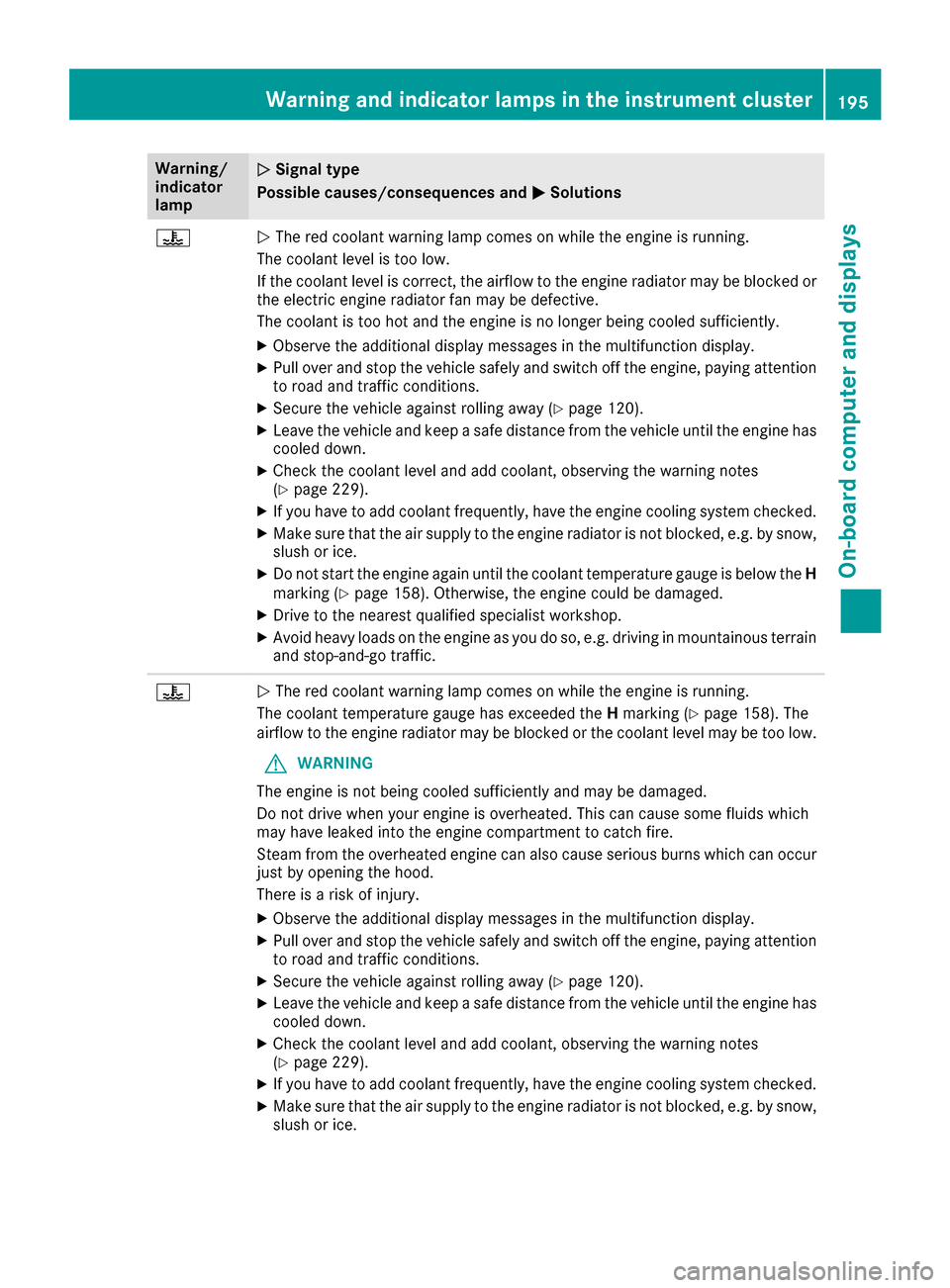
Warning/
indicator
lampNSignal type
Possiblec auses/consequences and M
Solutions
?NThe red coolant warning lamp comes on while the engine is running.
The coolant levelist oo low.
If the coolant levelisc orrect, the airflow to the engine radiator may be blocked or
the electric engine radiator fan may be defective.
The coolant is too hot and the engine is no longer being cooleds ufficiently.
XObserve the additionaldisplay messages in the multifunction display.
XPullover and stop the vehicles afelyand switch off the engine, paying attention
to road and traffic conditions.
XSecure the vehiclea gainst rolling away(Ypage120).
XLeave the vehiclea nd keepasafe distance from the vehicleu ntil the engine has
cooledd own.
XCheck the coolant levela nd add coolant, observing the warning notes
(Ypage2 29).
XIf you have to add coolant frequently, have the engine cooling system checked.
XMake sure that the air supply to the engine radiator is not blocked,e .g. by snow,
slush or ice.
XDo not start the engine again until the coolant temperature gauge is below the H
marking (Ypage1 58). Otherwise, the engine coul dbedamaged.
XDrive to the neares tqualified specialist workshop.
XAvoid heavy loads on the engine as you do so, e.g. driving in mountainous terrain
and stop-and-go traffic.
?N The red coolant warning lamp comes on while the engine is running.
The coolant temperature gauge has exceededt heHmarking (
Ypag e158) .The
airflow to the engine radiator may be blocked or the coolant levelm ay be too low.
GWARNING
The engine is not being cooleds ufficiently and may be damaged.
Do not drive when you rengine is overheated. This can caus esome fluids which
may have leaked into the engine compartment to catch fire.
Steam from the overheated engine can als ocaus eserious burns which can occur
just by opening the hood.
There is arisk of injury.
XObserve the additiona ldisplay messages in the multifunction display.
XPul lover and stop the vehicles afelyand switch off the engine, paying attention
to road and traffic conditions.
XSecure the vehiclea gainst rolling away(Ypage120).
XLeave the vehiclea nd keepasafe distance from the vehicleu ntil the engine has
cooledd own.
XCheck the coolant levela nd add coolant, observing the warning notes
(Ypage2 29).
XIf you have to add coolant frequently, have the engine cooling system checked.
XMake sure that the air supply to the engine radiator is not blocked,e .g. by snow,
slush or ice.
Warning and indicator lamps in the instrument cluster195
On-board computer and displays
Z
Page 198 of 286
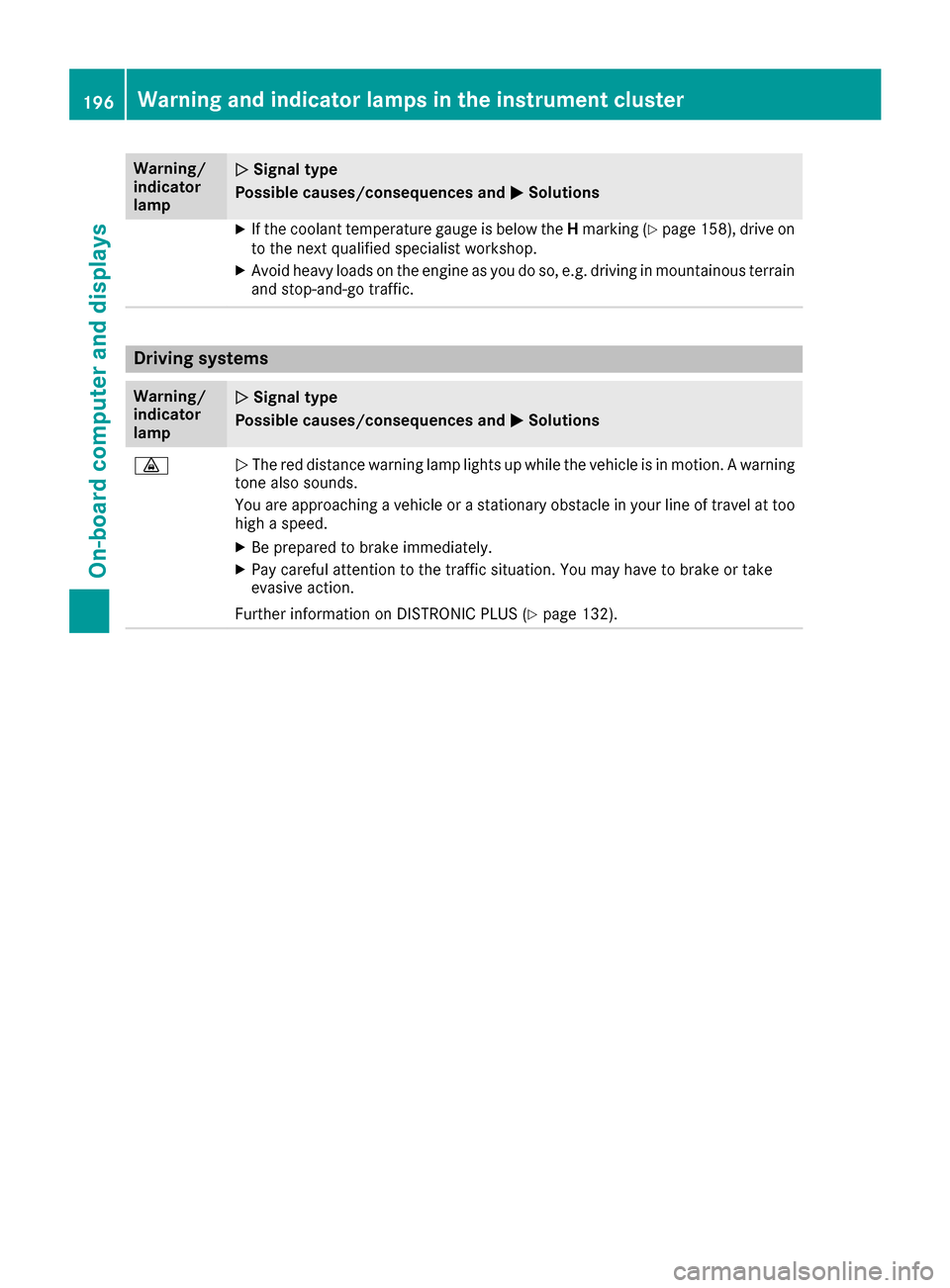
Warning/
indicator
lampNSignal type
Possiblec auses/consequences and M
Solutions
XIf the coolant temperature gauge is below the Hmarking (Ypag e158) ,drive on
to the next qualified specialist workshop.
XAvoid heavy loads on the engine as you do so, e.g. driving in mountainous terrain
and stop-and-go traffic.
Driving systems
Warning/
indicator
lampNSignal type
Possiblec auses/consequences and M
Solutions
·NThe red distance warning lamp lights up while the vehicleisinm otion.Awarning
tone als osounds.
You are approaching avehicleoras tationary obstacl einyourline of travel at too
high aspeed.
XBe prepared to brake immediately.
XPay carefu lattention to the traffic situation. You may have to brake or take
evasive action.
Further information on DISTRONIC PLUS (
Ypag e132).
196Warning and indicator lamps in the instrument cluster
On-board computer and displays
Page 206 of 286
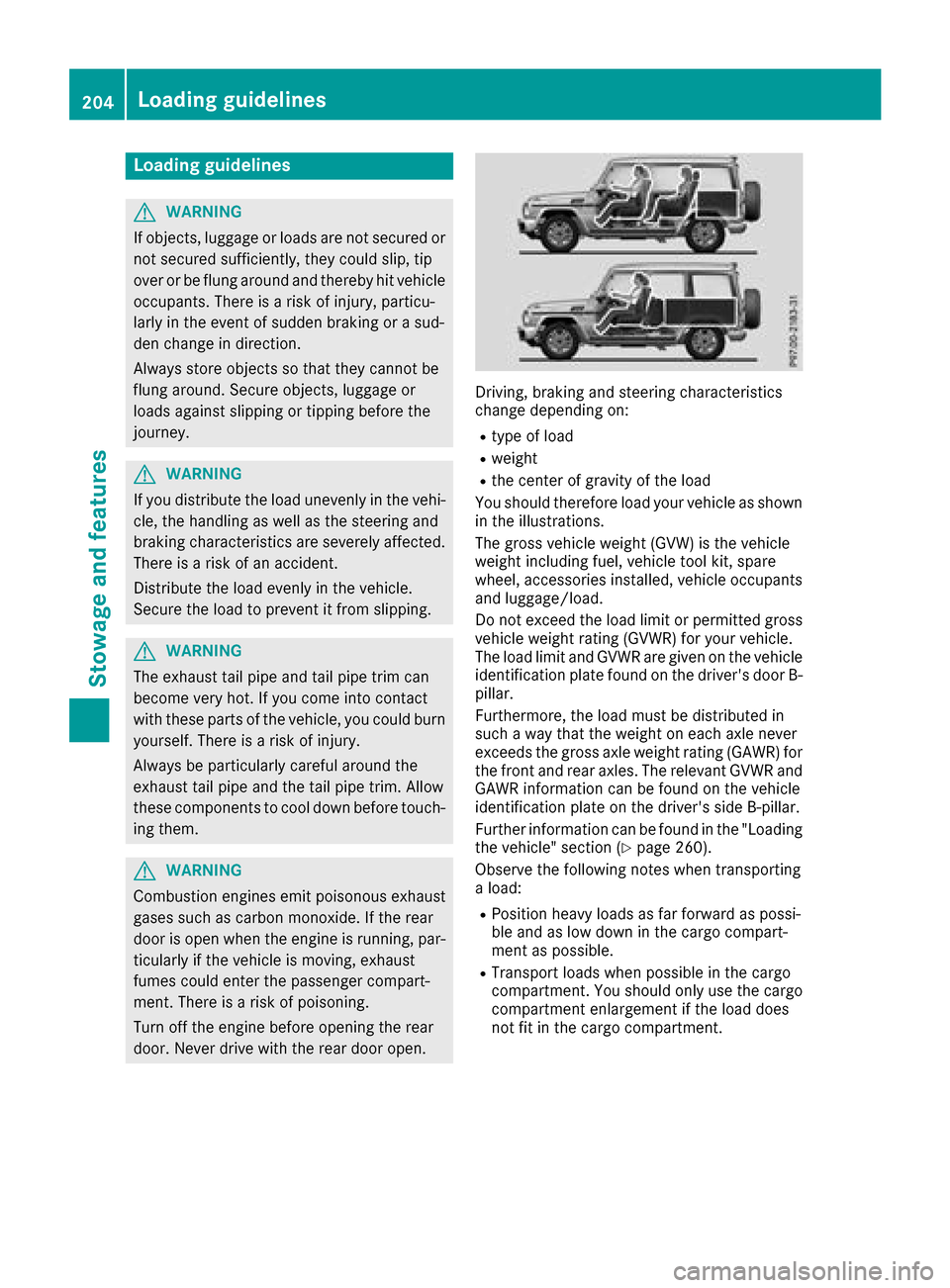
Loading guidelines
GWARNING
If objects, luggage or loads are not secured or
not secured sufficiently, they could slip, tip
over or be flun garounda nd thereb yhit vehicle
occupants. Thereisar isk of injury, particu-
larly in th eeventofs udden braking or asud-
den change in direction.
Always store object ssothatthe yc annot be
flun garound. Secure objects, luggage or
loads against slippingort ipping before the
journey.
GWARNING
If you distributet heload unevenl yinthevehi-
cle, th ehandlingasw ell as thesteerin gand
braking characteristic sare severely affected.
Thereisar isk of an accident.
Distributet heload evenly in th evehicle.
Secure th eload to prevent it fro mslipping.
GWARNING
The exhaust tail pipe and tail pipe trim can
become veryh ot.Ifyou com eintoc ontact
with these partsoft hevehicle ,you could burn
yourself. Thereisar isk of injury.
Always be particularly careful aroundt he
exhaust tail pipe and th etail pipe trim. Allow
these component stocooldown before touch-
ing them.
GWARNING
Combustio nengine semit poisonous exhaust
gases such as carbon monoxide. If th erear
door is open when th eengine is running, par-
ticularly if th evehicle is moving ,exhaust
fume scould enter th epassenge rcompart-
ment. Thereisar isk of poisoning.
Turn off th eengine before opening th erear
door.N ever driv ewith th erear door open.
Driving, braking and steeringc haracteristics
change depending on:
Rtype of load
Rweight
Rth ec enter of gravity of th eload
You should therefore load your vehicle as shown
in th eillustrations.
The gross vehicle weight (GVW) is th evehicle
weight includingf uel, vehicle tool kit ,spare
wheel, accessories installed, vehicle occupants
and luggage/load.
Do not exceed th eload limit or permitted gross
vehicle weight rating (GVWR) for your vehicle.
The load limit and GVWR are give nonthevehicle
identification platef oundont hedriver' sdoor B-
pillar.
Furthermore, th eload must be distributed in
such away that th eweight on each axle never
exceeds th egross axle weight rating (GAWR) for
th ef ront and rear axles .The relevant GVWR and
GAWR informatio ncan be foun donthevehicle
identification plateont hedriver' sside B-pillar.
Further informatio ncan be foun dinthe"Loading
th ev ehicle "sectio n(
Ypage 260).
Observe th efollowing notes when transporting
al oad:
RPosition heavy loads as far forward as possi-
ble and as low down in th ecargo compart-
mentasp ossible.
RTransportl oads when possible in th ecargo
compartment. You should onl yuse th ecargo
compartmente nlargement if th eload does
not fit in th ecargo compartment.
204Loading guidelines
Stowage and features
Page 209 of 286
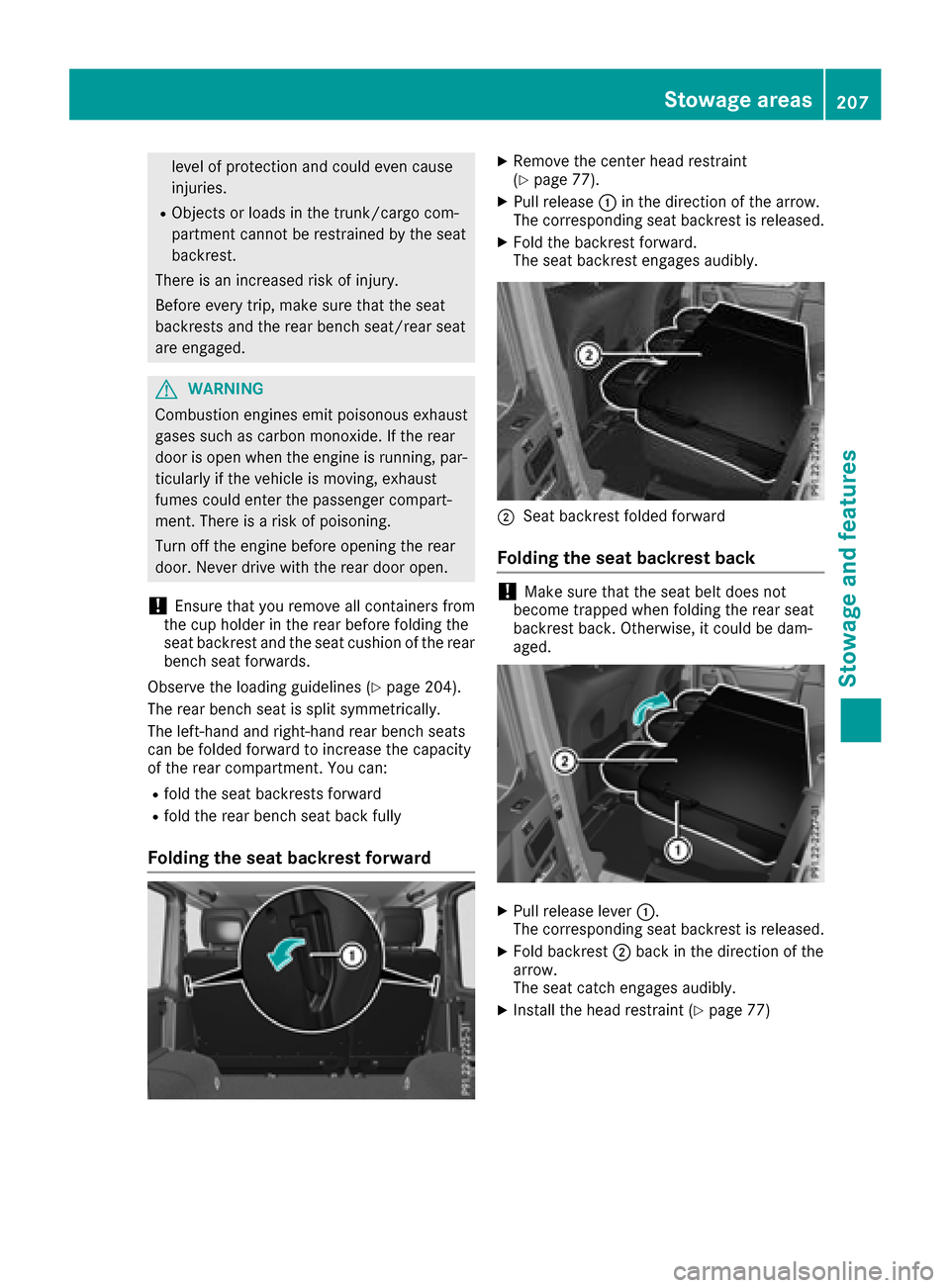
level of protection and could even cause
injuries.
RObjectsorloads in the trunk/cargo com-
partmentc annot be restraine dbythe seat
backrest.
There is an increased risk of injury.
Before everyt rip, make sure that the seat
backrestsa nd the rear benc hseat/rear seat
are engaged.
GWARNING
Combustion engines emit poisonous exhaust
gases such as carbo nmonoxide .Ifthe rear
door is open when the engin eisrunning, par-
ticularly if the vehicle is moving, exhaust
fumes could enter the passenger compart-
ment. There is arisk of poisoning.
Turn off the engin ebeforeo pening the rear
door. Never drive with the rear door open.
!Ensure that you remove all containers from
the cup holder in the rear beforef oldingthe
seat backrest and the seat cushio nofthe rear
benc hseat forwards.
Observe the loading guideline s(
Ypage 204).
The rear benc hseat is split symmetrically.
The left-han dand right-han drear benc hseats
can be folded forward to increase the capacity
of the rear compartment. You can:
Rfold the seat backrestsf orward
Rfold the rear benchseat back fully
Folding th eseat backrest forward
XRemove the center head restraint
(Ypage 77).
XPull release :in the direction of the arrow.
The correspondin gseat backrest is released.
XFold the backrest forward.
The seat backrest engages audibly.
;Seat backrest folded forward
Folding th eseat backrest back
!Make sure that the seat belt does not
becom etrapped when foldingt he rear seat
backrest back .Otherwise, it could be dam-
aged.
XPull release lever :.
The correspondin gseat backrest is released.
XFold backrest ;back in the direction of the
arrow.
The seat catch engages audibly.
XInstall the head restraint (Ypage 77)
Stowage areas207
Stowage and features
Z
Page 213 of 286
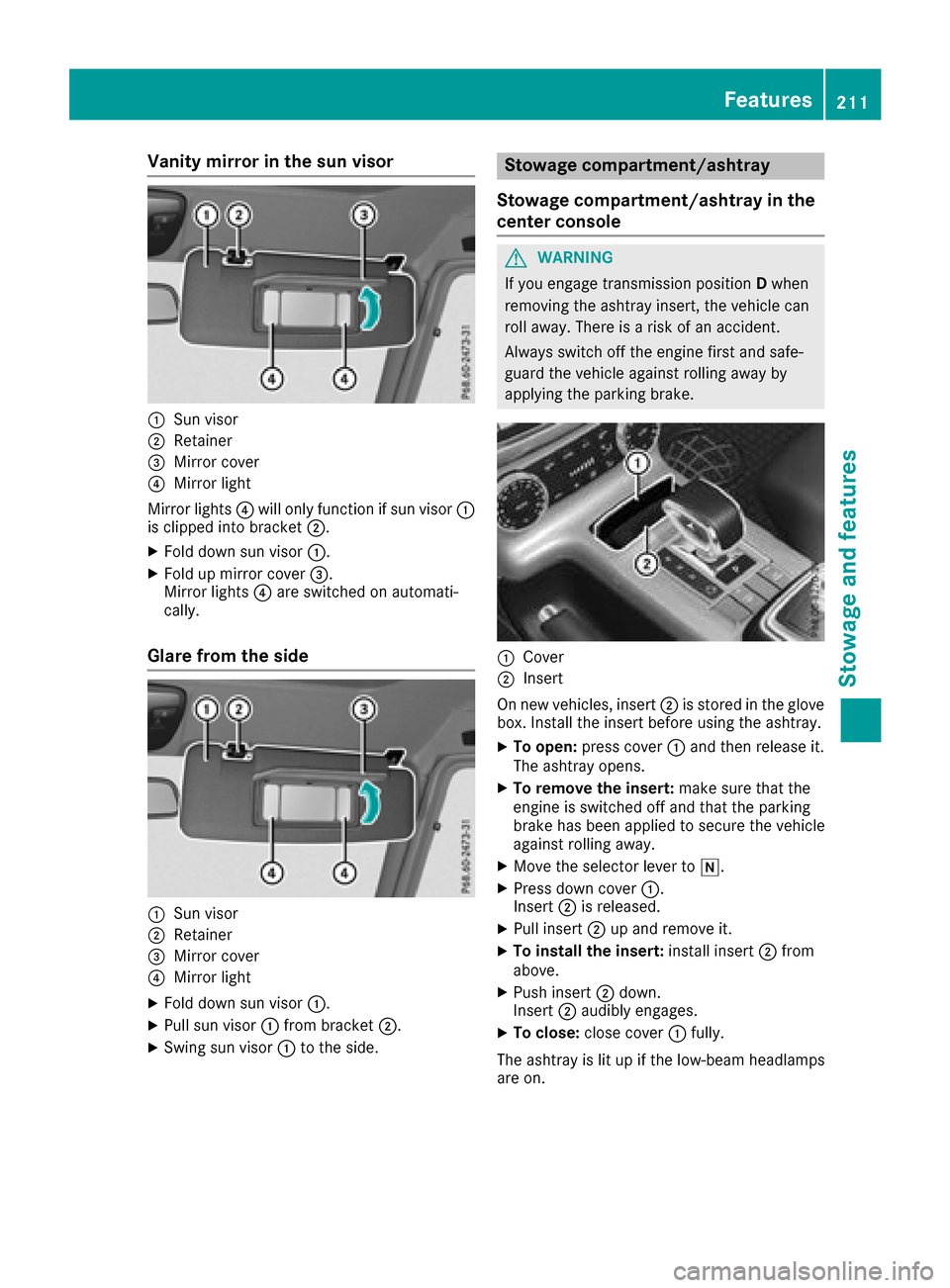
Vanity mirrorinthe sun visor
:Sun visor
;Retainer
=Mirror cover
?Mirror light
Mirror lights ?will onlyf unctionifsunvisor :
is clipped into bracket ;.
XFolddowns un visor :.
XFoldupm irror cover =.
Mirror lights ?are switched on automati-
cally.
Glare from the side
:Sun visor
;Retainer
=Mirror cover
?Mirror light
XFoldd owns un visor :.
XPull sunv isor:from bracket ;.
XSwing sunvisor:to the side.
Stowage compartment/ashtray
Stowage compartment/ashtray in the
centerc onsole
GWARNING
If yo uengage transmission position Dwhen
removing the ashtrayi nsert, the vehiclecan
rolla way. There is ariskofana ccident.
Alway sswitch off the engine first and safe-
guard the vehicl eagain st rolling away by
applying the parking brake.
:Cover
;Insert
On new vehicles, insert ;is stored in the glove
box. Install the insert before using the ashtray.
XTo open: press cover :and then release it.
The ashtrayo pens.
XTo remove the insert: make sure thatthe
engine is switched off and thatt he parking
brake hasb eena pplied to secure the vehicle
against rolling away.
XMov ethe selecto rlev er to i.
XPress down cover :.
Insert ;is released.
XPull insert ;up and remove it.
XTo installt he insert:installinsert ;from
above.
XPush insert ;down.
Insert ;audibl yengages.
XTo close: close cover :fully.
The ashtrayisl itup if the low-bea mheadlamps
are on.
Features211
Stowag eand featur es
Z
Page 216 of 286

Using the 115Vpower socketXTo switch on: switchthe ignition on.
XOpen flap :.
XInsert the plug of the electronic device into
115Vpower socket ;.
Indicator lamp =lights up.
XTo switch off: disconnectthe plug from
115 Vpower socket ;.
Ensure that you do not pull on the cord.
Problem swith the 115 Vpower socket
ProblemPossible causes/consequences and MSolutions
The warninglamp on the
115 Vpower socket is
not lit.The on-board voltage is too low because the battery is too weak.
XStart the engine.
or
XCharge the battery (Ypage 243).
If the indicator lamp still does not light up:
XVisit aqualified specialist workshop.
The temperature of the DC/A Cconverter is temporarily too high.
XRemove the electronic device connector from the 115 Vsocket.
XLet the DC/A Cconverter cool down.
If the indicator lamp still does not light up after coolingd own the
converter:
XVisit aqualified specialist workshop.
You have connected an electronic device that has aconstan tnominal
power of less than 150 watts, but has avery high switch-on current.
This device will not work. If you connec tsuch adevice, the 115 V
power socket will not supply it with power.
XConnect asuitable electronic device.
mbrace
Genera lnotes
The mbrace system is only available in the USA.
You must have alicens eagreementtoa ctivate
the mbrace service. Make sure that your system
is activated and operational. To register, press
the ï Infoc all button. If any of the steps
mentioned are not carried out, the system may
not be activated. If you have question
sabout the activation ,con-
tact one of the following telephon ehotlines:
Mercedes-Benz Customer Assistance Center at 1-800-FOR-MERCedes (1-800-367-6372) or
1-866-990-9007
Shortly after successfully registering with the
mbrace service, auser ID and password will be
sent to you by mail. You can use this password
to log ont othe mbrace area under "Owners
Online" at http://www.mbusa.com.
214Features
Stowage and features
Page 224 of 286

Alternatively,you can cal lthe following tele-
phone assistance services:
RUSA: Mercedes-Benz Customer Assistance
Center at 1-800-FOR-MERCedes
RCanada: Customer Service at
1-800-387-0100
RHomeLink®hotline 1-800-355-3515( free of
charge)
Mor einformatio nonHomeLink
®and/or com-
patible products is also availabl eonline at
http://www.homelink.com.
Notesont he declaratio nofconformity
(
Ypage 127).
USA: FCC ID: CB2HMIHL4
Canada: IC:2 79B-HMIHL4
USA only:
Thi sd evice complies with Part 15 of the FCC
Rules. Operatio niss ubject to the following two
conditions:
1. Thi sdevice mayn ot cause harmfuli nterfer-
ence ,and
2. thisd evice must accept any interference
received, including interference thatm aycause
undesired operation.
Any unauthorized modification to thisd evice
could voidt he user'sauthority to operate the
equipment.
Canad aonly:
Thi sd evice complies with RSS-210 of Industry
Canada. Operatio niss ubject to the following
two conditions:
1. Thi sdevice mayn ot cause harmfuli nterfer-
ence ,and
2. thisd evice must accept any interference
received, including interference thatm aycause
undesired operation.
Any unauthorized modification to thisd evice
could voidt he user'sauthority to operate the
equipment.
Important safety notes
GWARNING
Whe nyou operate or programt he garage door
with the integrated garage door opener, per-
sons in the range of movement of the garage
door can become trappe dorstruck by the
garage door. There is ariskofi njury.
Whenusing the integrated garage door
opener, always make sure thatn obodyis
withint he range of movement of the garage
door.
GWARNING
Combustion engine semitp oiso nousexhaust
gases such as carbo nmonoxide. Inhaling
thes eexhaus tgases lead stopoisoning. There
is ar iskoff atalinjury.T herefore neve rleave
the engine running in enclose dspaces with-
outs ufficient ventilation.
Programming
Programming
Pa ya ttentio ntothe "Important safety notes"
(Ypage 222).
Garage door remote control Ais not included
with the integrated garage door opener.
XDelete the memory of the integrated remote
control(Ypage 224) before programming it
for the first time.
XTurn the SmartKeytop osition 2
(Ypage 104 )inthe ignition lock.
XSelect one of buttons ;to? to us etoc on-
trol the garage door drive.
XTo start programmin gmode: press and
hol done of buttons ;to? on the integrated
garage door opener.
The garage door opene risnow in program-
ming mode. After ashort time ,indicator
lamp :will start flashing. It flashesa pprox-
imatelyo nce persecond.
Indicato rlam p: flashesi mmediatelyt he
first time thatt he transmitterbutton is pro-
grammed. If thist ransmitterbutton has
already been programmed, indicator lamp :
222Features
Stowageand featur es